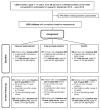Effects of Before-School Physical Activity on Obesity Prevention and Wellness
- PMID: 29449135
- PMCID: PMC5901979
- DOI: 10.1016/j.amepre.2018.01.017
Effects of Before-School Physical Activity on Obesity Prevention and Wellness
Abstract
Introduction: The effects of Build Our Kids Success-a 12-week, 1-hour before-school physical activity program-on BMI and social-emotional wellness among kindergarten to eighth grade students was examined.
Study design: This was a nonrandomized trial.
Setting/participants: Participants were from 24 schools in Massachusetts; there were 707 children from kindergarten to eighth grade.
Intervention: Children registered for Build Our Kids Success in 2015-2016 participated in a 2 days/week or 3 days/week program. Nonparticipating children served as controls.
Main outcome measures: At baseline and 12 weeks, study staff measured children's heights/weights; children aged ≥8 years completed surveys. Main outcomes were 12-week change in BMI z-score, odds of a lower BMI category at follow-up, and child report of social-emotional wellness. Analyses were completed in March-June 2017.
Results: Follow-up BMI was obtained from 67% of children and self-reported surveys from 72% of age-eligible children. Children in the 3 days/week group had improvements in BMI z-score (-0.22, 95% CI= -0.31, -0.14) and this mean change was significantly different than the comparison group (-0.17 difference, 95% CI= -0.27, -0.07). Children in the 3 days/week group also had higher odds of being in a lower BMI category at follow-up (OR=1.35, 95% CI=1.12, 1.62); significantly different than the comparison group (p<0.01). Children in the 2 days/week program had no significant changes in BMI outcomes. Children in the 3 days/week group demonstrated improvement in their student engagement scores (0.79 units, p=0.05) and had nonsignificant improvements in reported peer relationships, affect, and life satisfaction versus comparison. The 2 days/week group had significant improvements in positive affect and vitality/energy versus comparison.
Conclusions: A 3 days/week before-school physical activity program resulted in improved BMI and prevented increases in child obesity. Both Build Our Kids Success groups had improved social-emotional wellness versus controls.
Trial registration: This study is registered at www.clinicaltrials.gov NCT03190135.
Copyright © 2018 American Journal of Preventive Medicine. Published by Elsevier Inc. All rights reserved.
Figures
References
-
- Ogden CL, Carroll MD, Fryar CD, Flegal KM. Prevalence of obesity among adults and youth: United States, 2011–2014. NCHS Data Brief. 2015;(219):1–8. - PubMed
-
- Dencker M, Thorsson O, Karlsson MK, et al. Daily physical activity related to body fat in children aged 8–11 years. J Pediatr. 2006;149(1):38–42. https://doi.org/10.1016/j.jpeds.2006.02.002. - DOI - PubMed
-
- Sijtsma A, Sauer PJ, Stolk RP, Corpeleijn E. Is directly measured physical activity related to adiposity in preschool children? Int J Pediatr Obes. 2011;6(5–6):389–400. https://doi.org/10.3109/17477166.2011.606323. - DOI - PubMed
-
- Reilly JJ. Physical activity, sedentary behaviour and energy balance in the preschool child: opportunities for early obesity prevention. Proc Nutr Soc. 2008;67(3):317–325. https://doi.org/10.1017/S0029665108008604. - DOI - PubMed
-
- Sallis JF, Prochaska JJ, Taylor WC. A review of correlates of physical activity of children and adolescents. Med Sci Sports Exerc. 2000;32(5):963–975. https://doi.org/10.1097/00005768-200005000-00014. - DOI - PubMed
Publication types
MeSH terms
Associated data
Grants and funding
LinkOut - more resources
Full Text Sources
Other Literature Sources
Medical


